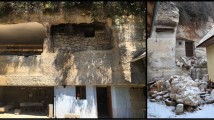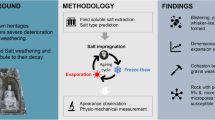Abstract
Cultural monuments and geological heritage sites composed of natural stone are severely affected by frost weathering in cold regions or during the winter season in mid-altitude regions. The effect also occurs at the dinosaur tracksite in Seoyu-ri, Hwasun, Korea, which is not sheltered. To assess the influence of frost weathering on the tracksite, freeze–thaw experiments were carried out in the laboratory up to 100 cycles, simulating geological and meteorological conditions of the site. The variation on physical properties were measured at a core scale as weathering progressed. The decreases in dry weight, P- and S-wave velocity, and elastic modulus, and the increase in absorption rate and Poisson’s ratio showed the physical deterioration of the specimens. The microstructural properties were also measured using micro-computed tomography (micro-CT) images as weathering progressed. The variation on porosity (especially open porosity), pore size distribution, local thickness, and crack orientation showed the propagation and expansion of the pores and microcracks in rock specimens at a pore scale. Because every measurement was performed using non-destructive methods, the variation on the same specimens can be analyzed continuously. The results showed that frost weathering can cause damage to the tracksites. This research, therefore, suggests the construction of a shelter to maintain the temperature of the tracksite and to prevent groundwater seepage. This research can be applied to assess the effects of frost weathering at other cultural stone heritage or geological heritage sites.










Similar content being viewed by others
References
Altindag R, Alyildiz IS, Onargan T (2004) Mechanical property degradation of ignimbrite subjected to recurrent freeze–thaw cycles. Int J Rock Mech Min 41:1023–1028. doi:10.1016/j.ijrmms.2004.03.005
Bland W, Rolls D (1998) Weathering: Am introduction to the scientific principles. Arnold, London
Brown ET (1981) Rock characterization testing & monitoring. Pergamon Press, Oxford
Camuffo D (2014) Microclimate for cultural geritage. Elsevier, Oxford
Davidson GP, Nye JF (1985) A photoelastic study of ice pressure in rock cracks. Cold Reg Sci Technol 11:141–153. doi:10.1016/0165-232X(85)90013-8
De Kock T, Boone MA, De Schryver T, Van Stappen J, Derluyn H, Masschaele B, De Schutter G, Cnudde V (2015) A pore-scale study of fracture dynamics in rock using X-ray micro-CT under ambient freeze–thaw cycling. Environ Sci Technol 49:2867–2874. doi:10.1021/es505738d
Delerue JF, Perrier E, Yu ZY, Velde B (1999) New algorithms in 3D image analysis and their application to the measurement of a spatialized pore size distribution in soils. Phys Chem Earth Pt A 24:639–644
Fagerland G (1973) Determination of pore-size distribution from freezing-point depression. Matér et Constr 6:215–225
French HM (2007) The periglacial environment. Wiley, West Sussex
Grassegger G (1999) Decay mechanisms of natural building stones on monuments: A review of the latest theories. In: Stumpp S, Krüger M, Große C (ed) Werkstoffe und Werkstoffprüfung im Bauwesen. Institut für Werkstoffe im Bauwesen, Universität Stuttgart, Stuttgart, pp 54–81
Hall K (1999) The role of thermal stress fatigue in the breakdown of rock in cold regions. Geomorphology 31:47–63
Houck KJ, Lockley MG (2006) Life in an active volcanic arc: petrology and sedimentology of dinosaur track beds in the Jindong Formation (Cretaceous), Gyeongsang Basin, South Korea. Cretac Res 27:102–122. doi:10.1016/j.cretres.2005.10.004
Huh M, Paik IS, Lockley MG, Hwang KG, Kim BS, Kwak SK (2006) Well-preserved theropod tracks from the Upper Cretaceous of Hwasun County, southwestern South Korea, and their paleobiological implications. Cretac Res 27:123–138. doi:10.1016/j.cretres.2005.10.003
Kim BS, Huh M (2010) Analysis of the acceleration phase of a theropod dinosaur based on a Cretaceous trackway from Korea. Palaeogeogr Palaeocl 293:1–8. doi:10.1016/j.palaeo.2010.04.020
Kim JY, Lockley MG (2012) New sauropod tracks (Brontopodus pentadactylus ichnosp. nov.) from the early cretaceous haman formation of Jinju Area, Korea: implications for sauropods manus morphology. Ichnos 19:84–92. doi:10.1080/10420940.2012.664056
Kim BK, Park BK (1966) The geological map of Dongbok sheet (1:50,000). Geological Survey of Korea, Seoul (in Korean)
Lee SK, Park HD (2014) Comparison of observation and laboratory slaking tests in the assessment of coastal erosion in Cheju Island, Korea. Geosyst Eng 17:136–141. doi:10.1080/12269328.2014.931258
Lockley MG, Huh M, Kim BS (2012) Ornithopodichnus and pes-only sauropod trackways from the hwasun tracksite, cretaceous of Korea. Ichnos 19:93–100. doi:10.1080/10420940.2011.625726
Martínez-Martínez J, Benavente D, Gomez-Heras M, Marco-Castaño L, García-del-Cura MÁ (2013) Non-linear decay of building stones during freeze–thaw weathering processes. Constr Build Mater 38:443–454. doi:10.1016/j.conbuildmat.2012.07.059
Masuoka N (1990) Mechanisms of rock breakdown by frost action: an experimental approach. Cold Reg Sci Technol 17:253–270
Minter NJ, Lockley MG, Huh M, Hwang KG, Kim JY (2012) Lithographus, an abundant arthropod trackway from the cretaceous haenam tracksite of Korea. Ichnos 19:115–120. doi:10.1080/10420940.2011.625756
Murton JB, Coutard JP, Lautridou JP, Ozouf JC, Robinson DA, Williams RBG (2001) Physical modelling of bedrock brecciation by ice segregation in permafrost. Permafr Periglac 12:255–266. doi:10.1002/ppp.390
Nicholson DT, Nicholson FH (2000) Physical deterioration of sedimentary rocks subjected to experimental freeze–thaw weathering. Earth Surf Process Landf 25:1295–1307. doi:10.1002/1096-9837(200011)25:12<1295:AID-ESP138>3.0.CO;2-E
Paik IS, Huh M, Park KH, Hwang KG, Kim KS, Kim HJ (2006) Yeosu dinosaur track sites of Korea: the youngest dinosaur track records in Asia. J Asian Earth Sci 28:457–468. doi:10.1016/j.jseaes.2005.11.007
Park J, Hyun CU, Park HD (2015) Changes in microstructure and physical properties of rocks caused by artificial freeze–thaw action. Bull Eng Geol Environ 74:555–565. doi:10.1007/s10064-014-0630-8
Potts AS (1970) Frost action in rocks: some experimental data. T I Brit Geogr 49:109–124
Prick A (1997) Critical degree of saturation as a threshold moisture level in frost weathering of limestones. Permafr Periglac 8:91–99. doi:10.1002/(SICI)1099-530(199701)8:1<91:AID-PPP238>3.0.CO;2-4
Ruiz de Argandoña VG, Rodríguez Rey A, Celorio C, Suárez del Río LM, Calleja L, Llavona J (1999) Characterization by computed X-ray tomography of the evolution of the pore structure of a dolomite rock during freeze-thaw cyclic tests. Phys Chem Earth Pt A 24:633–637
Saliu M, Lawal AI (2014) Investigations of weathering effects on engineering properties of Supare granite gneiss. J Min World Express 3:53–62. doi:10.14355/mwe.2014.03.008
Shang Y, Yue Z, Park HD, Hyun CU (2015) Brittle fracture and plastic creep of the completely decomposed granite presented in CT. Geosyst Eng 18:338–347. doi:10.1080/12269328.2015.1075438
Shen B, Jung YB, Park ES, Kim TK (2015) Modelling the effect of ice swelling in the rock mass around an LNG underground storage cavern using FRACOD. Geosyst Eng 18:181–198. doi:10.1080/12269328.2015.1044575
Thomachot C, Matsuoka N (2007) Dilation of building materials submitted to frost action. In: Přikryl R, Smith BJ (eds) Building stone decay: from diagnosis to conservation. Geol Soc, London, pp 167–177
Tugrul A, Zarif IH (2000) The influence of weathering on the geological and geomechanical characteristics of a sandstone in Istanbul, Turkey. Environ Eng Geosci 6:403–412. doi:10.2113/gseegeosci.6.4.403
Walder JS, Hallet B (1986) The physical basis of frost weathering: toward a more fundamental and unified perspective. Arctic Alp Res 18:27–32
Wiman S (1963) A Preliminary study of experimental frost weathering. Geogr Ann 45:113–121. doi:10.2307/520387
Yang SY (1982) On the dinosaur’s footprints from the upper cretaceous gyeongsang group, Korea. J Geol Soc Korea 18:37–48 (in Korean with English abstract)
Acknowledgements
This work was supported by the National Research Foundation of Korea (NRF) grant funded by the Korea government (MEST; no. 2011-0027520).
Author information
Authors and Affiliations
Corresponding author
Rights and permissions
About this article
Cite this article
Park, J., Park, HD. The effect of frost weathering at the dinosaur tracksite in Seoyu-ri, Hwasun, Korea. Bull Eng Geol Environ 76, 1417–1429 (2017). https://doi.org/10.1007/s10064-016-0970-7
Received:
Accepted:
Published:
Issue Date:
DOI: https://doi.org/10.1007/s10064-016-0970-7




